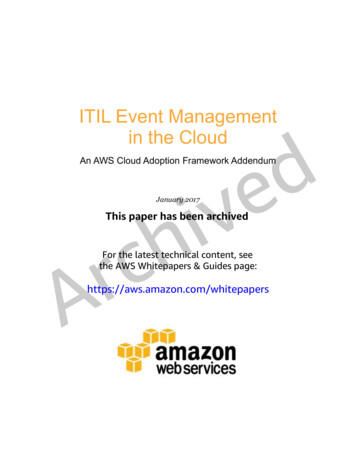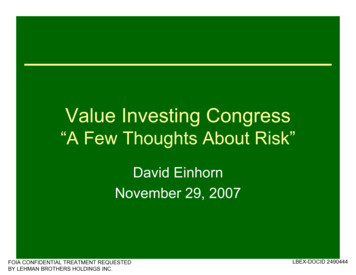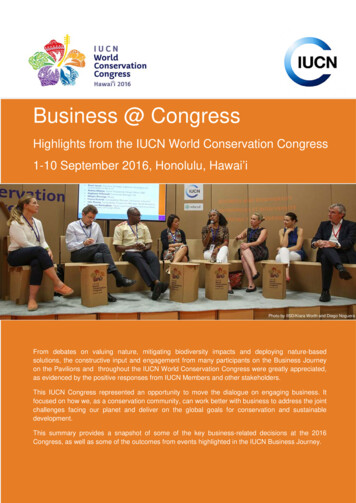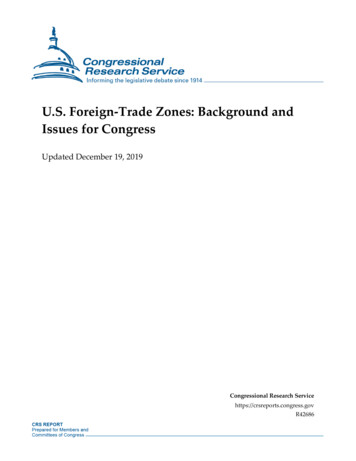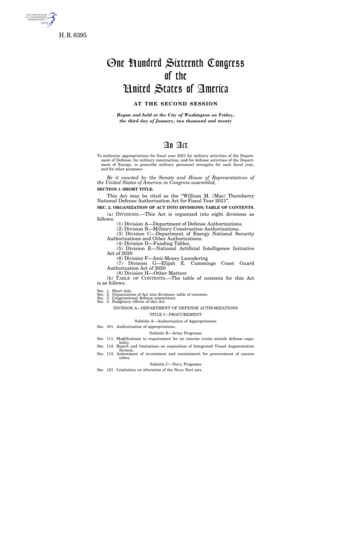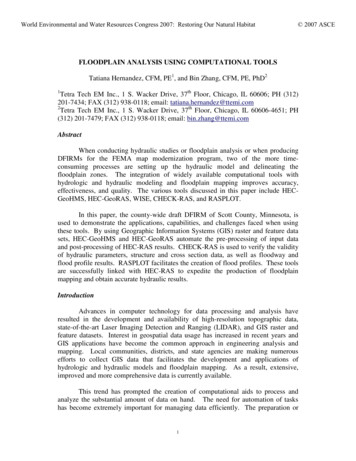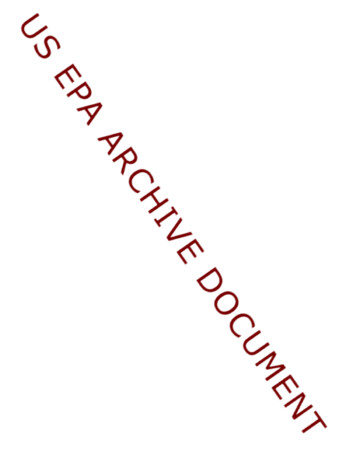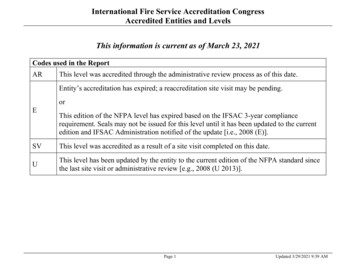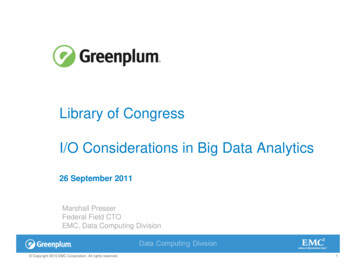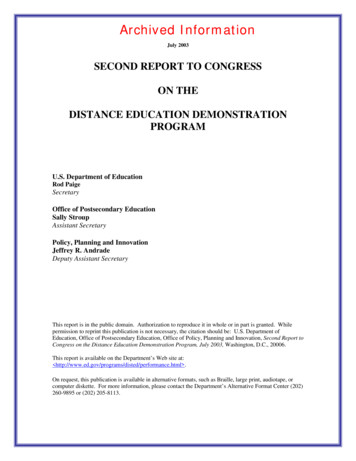
Transcription
Archived InformationJuly 2003SECOND REPORT TO CONGRESSON THEDISTANCE EDUCATION DEMONSTRATIONPROGRAMU.S. Department of EducationRod PaigeSecretaryOffice of Postsecondary EducationSally StroupAssistant SecretaryPolicy, Planning and InnovationJeffrey R. AndradeDeputy Assistant SecretaryThis report is in the public domain. Authorization to reproduce it in whole or in part is granted. Whilepermission to reprint this publication is not necessary, the citation should be: U.S. Department ofEducation, Office of Postsecondary Education, Office of Policy, Planning and Innovation, Second Report toCongress on the Distance Education Demonstration Program, July 2003, Washington, D.C., 20006.This report is available on the Department’s Web site at: http://www.ed.gov/programs/disted/performance.html .On request, this publication is available in alternative formats, such as Braille, large print, audiotape, orcomputer diskette. For more information, please contact the Department’s Alternative Format Center (202)260-9895 or (202) 205-8113.
SECOND REPORT TO CONGRESSON THEDISTANCE EDUCATION DEMONSTRATION PROGRAMTABLE OF CONTENTSEXECUTIVE SUMMARY . iiiINTRODUCTION. 1INCREASING ACCESS . 3Distance Education Delivery Modes . 3Programs and Enrollments . 4Student Characteristics. 6STUDENT SUCCESS. 8Course Completion . 8Program Retention and Completion . 9STUDENT AID ISSUES . 11Barriers to Increasing Course Start Dates . 11Defining a Program . 13Year Round Enrollment. 13Consortial Arrangements. 14Competency-based Models . 15Student-based Administration of Aid in Credit Programs. 17CONCLUSIONS . 19Policy Perspectives . 20APPENDIX – Summary Information for Current Participants . 22ii
EXECUTIVE SUMMARYThis is the second report to Congress concerning the results of the DistanceEducation Demonstration Program. The demonstration program was authorized byCongress in the 1998 reauthorization of the Higher Education Act of 1965 (HEA) to: testthe quality and viability of expanded distance education programs currently restrictedunder the HEA; provide for increased student access to higher education through distanceeducation; and help determine the most effective means of delivering quality educationvia distance education, the specific statutory and regulatory requirements that should bealtered to provide greater access to distance education, and the appropriate level of HEATitle IV student financial assistance for students enrolled in distance education programs.The Department initiated the demonstration program on July 1, 1999 with 15participants (one of which was removed from the program in the first year) and addednine additional participants in July 2002, as authorized by the statute. Currentparticipants include 17 individual institutions, four systems, and two consortia, for a totalof 107 institutions. Participants were selected through a competitive process usingstatutory criteria that included, among other things, the number and quality ofapplications received and diversity with respect to institutional size, mission, andgeographic distribution. The distance education delivery methods used by participantsinclude correspondence study, two-way interactive videoconferencing, videotapes, andthe Internet. The use of online instruction is increasing at a rapid rate at all participatinginstitutions to deliver certificate and full-degree programs as well as individual coursesthat are available both to students studying at a distance and on-campus. Almost allparticipants offer distance education degree programs in business andcomputer/information science. Other popular disciplines include liberal arts or generalstudies, health professions and social sciences at the bachelor’s degree level andeducation, engineering and psychology at the graduate level.Sixteen participants received waivers of the three provisions that relate to theamount of correspondence education an institution eligible for the Title IV studentfinancial assistance programs may provide (the “50% rules”). Seven are currently usingthese waivers to continue to participate in the Federal student aid programs. Fourteenparticipants received waivers for provisions relating to the required length of a programand definition of a week of instruction (the “12-hour rule”).1 Seven received waivers ofthe definition of a full-time student as it relates to correspondence study, and threereceived waivers of the requirements relating to satisfactory academic progress. WesternGovernors University received additional waivers, as provided in the authorizing statute,because of its unique structure.Both the number of distance education programs provided by participants andenrollments in these programs increased during 2000-01. The number of studentsenrolled in distance education programs offered by the initial cohort of participants has1The Department published final regulations on November 1, 2002 that replaced the 12-hour rule with theone day rule for non-standard and nonterm structures, coupled with the requirement that a calendar timeelement must be met before subsequent disbursement of Title IV funds can be made.iii
more than doubled since the 1998-99 academic year, from just under 13,000 to over27,000. There has been considerable growth as well in the number of onsite studentswho are taking distance education courses. This total increased from 19,000 to over42,000 in the same three-year period. Participants report significant progress in meetingindividual goals related to increasing access to their programs and services byunderserved populations.Comparative data on persistence and completion for cohorts of students who areenrolled in distance education and onsite programs, and those taking a mix of distanceeducation and onsite courses, indicate that the greatest success is experienced by the lattergroup at all degree levels.2 These early findings for distance education and onsiteprograms differ depending upon degree level. At the graduate degree level, there is atendency for retention to be higher for distance education than onsite programs, while atthe lower degree levels this tendency is reversed. However, the gap between the twonarrows with time. The gap appears to be a function of the high percentage of part-timestudents who are enrolled in distance education programs. The mode of distanceeducation delivery does not appear to be a salient factor in student outcomes fordemonstration program participants.The Department’s experience working with participants has provided insight intothe ways that current laws and regulations governing Title IV student financial assistanceprograms may inhibit institutions from designing programs that afford maximumflexibility for students and accommodate innovative instructional approaches. In additionto the requirements relating to the amount of distance education an institution mayprovide, and the requirements relating to time, the lack of consistency across the studentfinancial aid programs make it difficult for institutions to effectively manage the Federalstudent aid programs when they offer programs in other than standard terms or in a mixof term structures.The Department has uncovered no evidence that waiving the 50% rules, or any ofthe other rules for which waivers were provided, has resulted in any problems or hadnegative consequences. Three years of experience working with the demonstrationprogram participants indicates that the potential risk to Title IV student financialassistance programs has more to do with the financial viability and administrativecapability of the institution than with the mode of delivery in which the education isoffered.Based upon the experience gained to date through the demonstration program, andthe trends that are evident in the development of distance education generally, theDepartment recognizes the need to amend the laws and regulations governing Title IVstudent financial assistance in order to expand distance education opportunities. Thedemonstration program has been an excellent vehicle for developing and testing newapproaches, and its participants have devised some very interesting models.2There is insufficient data to report on comparative outcomes for students enrolled in certificate programs.iv
INTRODUCTIONThe Distance Education Demonstration Program was authorized by Congress inthe 1998 reauthorization of the Higher Education Act of 1965 (HEA) in section 486. Thepurpose of the demonstration program is to: (1) test the quality and viability of expandeddistance education programs currently restricted under the HEA; (2) provide forincreased student access to higher education through distance education; and (3) helpdetermine the most effective means of delivering quality education via distanceeducation, the specific statutory and regulatory requirements that should be altered toprovide greater access to distance education and the appropriate level of Title IV studentfinancial assistance for students enrolled in distance education programs.The authorizing legislation stipulated that the Secretary should select 15participants for the first year of the demonstration program, which began on July 1, 1999and up to 35 additional participants in its third year, commencing July 1, 2001. Thirteenof the original participants continue in the program3 and nine participants joined theprogram as part of the second cohort. Current participants include: Five private, for-profit institutions – American InterContinental University,Capella University, Quest Education Corp/Kaplan College, University of Phoenixand Walden University.Seven private, non-profit institutions – Franklin University, Marlboro College,New York University, Regis University, Southern Christian University, theUnited States Sports Academy, and Western Governors University.Five public universities – Eastern Oregon University, Florida State University,Texas Tech University, University of Maryland University College, andWashington State University.One community college– Brevard Community College.Two private consortia – Latter Day Saints Church Education System andJesuitNET Consortium.Two public systems/consortia – North Dakota University System and aconsortium of Washington State University and the community and technicalcolleges in Washington.One public/private consortium – Connecticut Distance Learning ConsortiumParticipants have received waivers of certain statutory and regulatory provisionsgoverning the HEA Title IV student financial assistance programs to enable them toprovide Title IV aid to distance education students more efficiently and, in someinstances, to expand their distance education programs beyond otherwise applicablestatutory limits. The waiver authority granted to the Secretary is limited to: the requirements of section 472(5) as the section relates to computer costs4;3Masters Institute was removed from the program in the first year for improperly administering Title IVprograms and the Community Colleges of Colorado voluntarily left the program in 2002.4The 1998 Amendments to the HEA removed the restriction on including the cost to rent or purchasecomputer equipment for students receiving instruction by telecommunications. Effective October 1, 1998,1
sections 481(a) and 481(b) as they relate to requirements for a minimum numberof weeks of instruction;sections 102(a)(3)(A) and 102(a)(3)(B) – the 50% institutional eligibilityrequirements;section 484(l)(1) as it relates to the definition of a telecommunications student asa correspondence student;one or more of the regulations prescribed under parts F5 and G of Title IV of theHEA that inhibit the operation of quality distance education programs; andadditional waivers for Western Governors University because of its uniquestructure.The chart in the appendix summarizes information about Distance EducationDemonstration Program participants. A key to the waivers is provided. More detailedinformation about the participants is available on the demonstration program ml.the law specifies that there is no distinction made in the cost of attendance regarding the mode ofinstruction.5The HEA prohibits the U.S. Department of Education from regulating in this area.2
INCREASING ACCESSThe authorizing statute states that a primary purpose of the Distance EducationDemonstration Program is to provide increased student access to higher educationthrough distance education programs. Access can be limited in a number of differentways, including geography, student resources, time constraints, academic programsstructures, and institutional policies. The distance education delivery modes and programstructures used by demonstration program participants address these constraints to greaterand lesser degrees.Distance Education Delivery ModesFollowing is a brief discussion of each of the delivery modes used by programparticipants, followed by the names of the institutions employing each. Correspondence study – the institution mails lessons to students who workindependently and periodically submit assignments and examinations for gradingby an instructor. This mode poses the fewest barriers to student access since thedelivery system (U.S. Mail) is ubiquitous and students can typically begin acourse anytime, work at their own pace in a place of their choosing, and take sixmonths to a year to complete it. However, some institutions require their federalfinancial aid recipients to complete the coursework within a set time frame forreasons that will be discussed in the section on student aid issues.Texas Tech University, Brigham Young University, Eastern Oregon University,North Dakota University System institutions Interactive videoconferencing – telecommunications networks link a facultymember with students located in classrooms around the state or region. Thismethod brings the classroom closer to the students, but does not provide theflexibility of time. Students are required to be in a particular place at a particulartime, and, since these “extended classrooms” usually piggyback on the traditionalclassroom, students must wait to begin a course until the start of the quarter orsemester.North Dakota University System institutions; Washington Community andTechnical Colleges Telecourses – instruction is delivered on videotape (or through cable distribution)to students studying at home. Often, the telecourses are professionally producedby another entity (such as Coastline Community College, Dallas Telelearning,Annenberg/CPB project) and licensed by schools whose faculty adapt them asappropriate. Course packages include student study guides, instructor guides, andvideo programs. In some cases, institutions videotape their own faculty teachingon-campus classes. The trend in recent years is to incorporate web componentsand online communication through email and discussion groups.3
Brevard Community College, Charter Oak State College, Community Colleges ofColorado, Eastern Oregon University, Washington State University, WashingtonCommunity and Technical Colleges Asynchronous online instruction – students have access to electronic classroomsthat contain instructional materials with links to other online resources, and toolsto facilitate group discussion, small group activities, and one-to-onecommunication. Students can be located anywhere in the world where they haveaccess to a computer, a phone line and an Internet service provider. They canparticipate in a class “asynchronously” – that is, they do not have to be online at aparticular time, but can enter into an ongoing electronic discussion and completecourse modules whenever it is convenient for them. Because online instructiondoes not require a physical classroom, it provides a means for institutions toschedule courses to begin every week or even every day of the year.All demonstration program participants Synchronous online instruction – students at home log onto computers that arelinked through the Internet to faculty and students in a classroom. They caninteract with others in the classroom using communication tools such as an onlinechat function. Students have the option of viewing the streaming video of theclass at a time of their own choosing, but by doing so they lose the opportunity tointeract.Southern Christian UniversityPrograms and EnrollmentsThe number of students enrolled in distance education programs offered by theinitial cohort of participants has more than doubled since the 1998-99 academic year,from just under 13,000 to over 27,000. This growth is concentrated in degree programs,rather than certificate programs. Only a few of the participants report that they offercertificate programs by some form of distance education and all but one of these reportvery low enrollments. The exception is Capella University, which has more than doubledits offerings of online graduate certificate programs in three years. Data are reported inthe aggregate rather than by individual certificate program, so all that can be said aboutenrollments is that the ratio of the number of programs to the number of students hasincreased from 1:2 to 1:6.It is common for certificate programs to consist of a subset of courses from theinstitution’s degree programs. In many cases, students do not identify themselves ascertificate-seeking at the outset. Rather, they request the certificate after they havecompleted the requisite number of courses and make the decision that they will notcontinue to earn a degree, or upon completion of the degree program. Many institutionsconsider it a good marketing strategy to offer short-term certificate programs to attractstudents who may have specific training or professional development needs.4
There has been considerable growth as well in the number of onsite students whoare taking distance education courses. This total increased from 19,000 to over 42,000 inthe same three-year period, with almost every participant at least doubling the number ofstudents taking a mix of distance education and onsite courses. It is evident that distanceeducation provides flexibility for all types of students, not just those that are unable tocome to campus to pursue their education. It is also becoming increasingly clear that itwill not be possible to continue to make d
Capella University, Quest Education Corp/Kaplan College, University of Phoenix and Walden University. Seven private, non-profit institutions – Franklin University, Marlboro College, New York University, Regis University, Southern Christian University, the United
